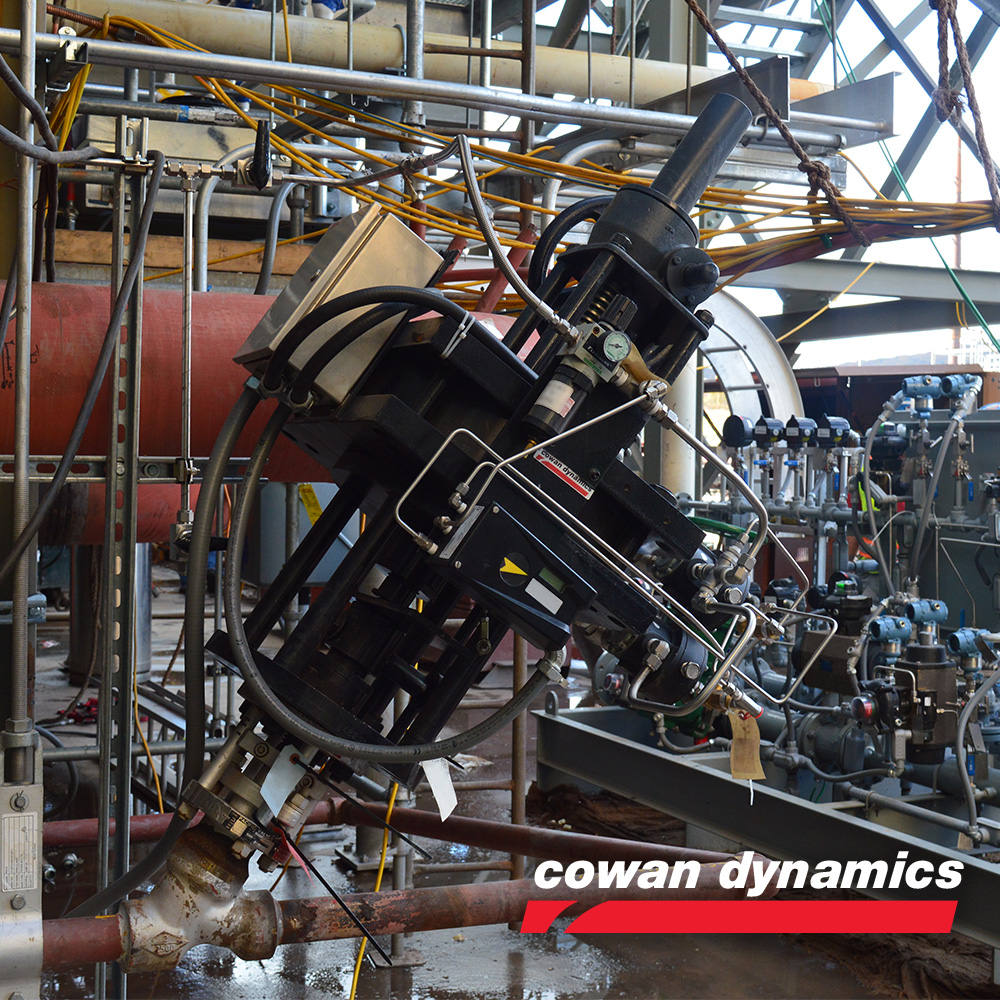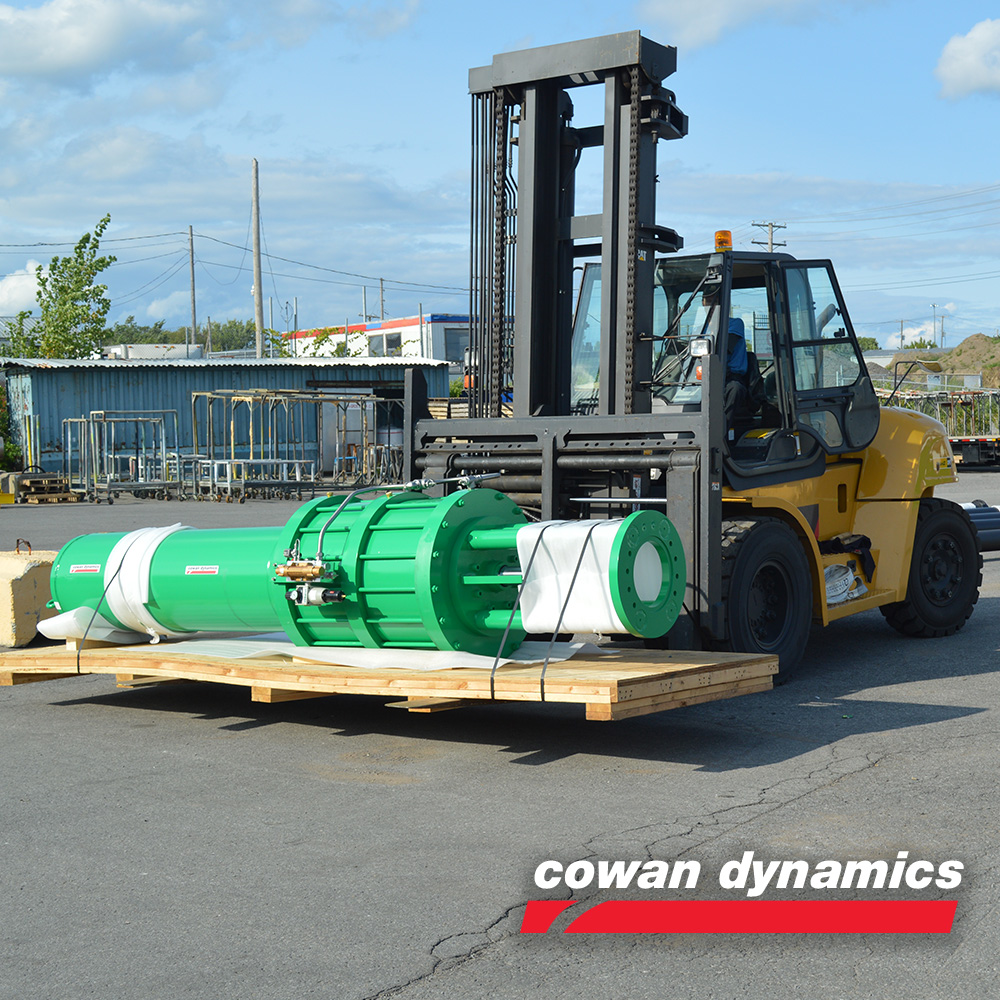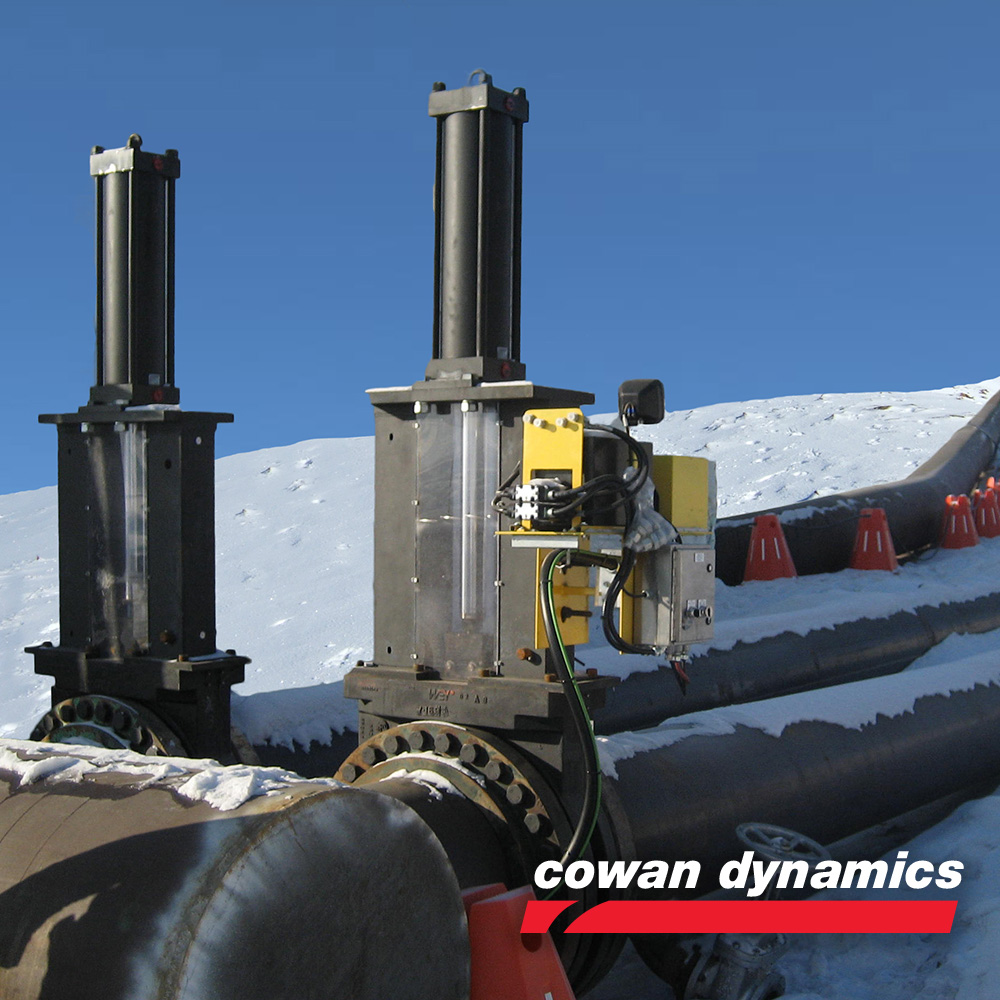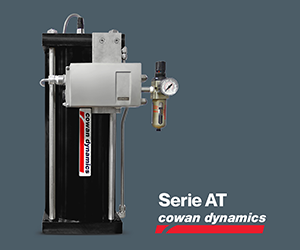Montreal, Quebec May 3, 2022 Cowan Dynamics, a leading industrial valve actuator manufacturer, continues to advance valve automation with the release of the E2H-ESD. The E2H-ESD actuator is the newest addition to their electro-hydraulic actuator lineup and is designed specifically for Emergency Shutoff Valve (ESD) automation. “In 2021 we released the ZE-ESD – a Zero Emission, ESD valve fail-safe system used in remote areas where power is not available. This product was successfully implemented and praised by remote pipeline operators.” Says Maria Aguirre, Director of Business Development. “Refineries and pipeline operators required more advanced valve automation for their ESD valves. We are pleased to announce the release of the E2H-ESD. The system provides ESD valve automation with...
Cowan Connection
Latest News from Cowan Dynamics
Patrick Berry – New Manufacturing Operations Director
We are really excited to welcome Patrick Berry to the team as our new Manufacturing Operations Director. Patrick brings over 25 years of experience in the design and manufacturing of fluid-powered systems. Patrick will be responsible for all engineering, manufacturing, and purchasing operations, we are sure he will accomplish great things. Welcome to the team Patrick!
After 25 Years at Cowan Dynamics – Happy Retirement Frank!
After 25 years with Cowan Dynamics, Frank is moving on to his next stage in life: a well-deserved retirement. Frank has started his career with us as a CNC lathe operator and all-around great machinist. He moved into the position of programmer, where his in-depth knowledge of machining processes really came to shine.His general helpfulness and willingness to go beyond the call of duty earned him the respect of management and his coworkers alike. Frank is now working on his golf game and hopefully will be equally successful at this new endeavor. From all of us: Happy retirement and see you on the links! Your friends at Cowan Dynamics.
Aymen Ghorbal, P. Eng. in the position of Director, Major Accounts
We are very excited to announce the appointment of Aymen Ghorbal, P. Eng. to the position of Director, Major Accounts. He will be responsible for managing our main accounts for long-term success and continuing our business development. We are sure he will accomplish great things. Congratulations Aymen!
We want to thank Instruvalve Perú
We want to thank Instruvalve Perú for welcoming Maria Eugenia Aguirre, Director of Business Development and we look forward to future collaborations in valve automation. Learn more: https://lnkd.in/de9EMJEg
Cowan Dynamics is excited to announce the appointment of Ana Munteanu
Cowan Dynamics Inc is excited to announce the appointment of Ana Munteanu, CGMA, to the position of Director, Commercial Finance. Ana will be responsible for all Finance Reporting, Analysis, and Planning and will oversee and manage commercial business processes, with a focus on consistency, accuracy, and structure. We are thrilled to have her taking on this role. Congratulations Ana!
What is an anti-surge valve?
An anti-surge valve is specifically designed and installed to protect the compressor from reaching its surge point. The valve is in the system, in a by-pass that connects the inlet and the outlet of the compressor. In normal operation, this valve remains closed, however, if the surge is detected, it quickly opens to maintain a minimum flow and directs the backflow to the outlet of the compressor to avoid damages. The valve must be completed with controllers that use the suction and discharge pressure and temperatures to determine the flow at which the condition of surge will occur. It is crucial for such valves to be operated by actuators that can achieve extremely fast stroking times, high frequency of operation minimal dead time and minimal overshoot. What is compressor surge? In...
📖 Delayed Coking & Delayed Coker Unit Reference Guide
Coking Refinery Types Delayed Coking Delayed Coking is a refinery unit operation that upgrades the lowest value bottoms material (vacuum resid) from the atmospheric or vacuum distillation column and cracks it to the point that all of the resid is eliminated. This process yields lighter fractions and solid carbon into higher-value products and produces petroleum coke—a coal-like material. During the cracking process, a firing heater with horizontal tubes is used to achieve temperatures ranging from 485 to 505 C (905 to 941 F). Coking in the furnace tubes is, therefore "delayed" until the feed material reaches large coking drums downstream of the heater. You can produce petroleum coke in three physical structures: shot, sponge, or needle. Simply put, a delayed coking unit (DCU) processes...
The Importance of Valve Positioners
The valve positioner is a feedback mechanism. It allows valves to be positioned precisely in accordance with the output signal of the controller, in the presence of major disturbances caused by unbalanced forces acting on the valve stem, changes in actuator temperature, etcetera. Even a relatively small actuator, that otherwise would have to be bench-set to an unacceptable degree, can be stroked precisely when a valve positioner is used to signal the valve position. Positioners are not now considered to be the universal solution to many problems. In fact, in some control circuits the effect of fitting a positioner can be detrimental. Whilst it is an advantage to use positioners in slow systems, it can be a disadvantage in the case of control loops with short reset times. A positioner...
Maximize flotation cell mineral recovery
In this article you'll learn to maximize mineral recovery in a flotation cell. Dart valves have traditionally been used as level control valves in flotation cells. The dart valve positioning in flotation cells requires high consideration as the goal is to maximize mineral recovery. For this reason a reliable and accurate control valve actuator is crucial. Pneumatic actuators vs electro-hydraulic actuators for dart valve control Traditionally dart valves use pneumatic actuators to control the flotation cell level. However, due to air compression or elasticity, this method of automation can cause problems in accurate and efficient level control. The thrust due to the pressures at the bottom of the cell acts against...
When to Use a Globe Valve Actuator
In this article, you will learn about the globe valve, when to use it, and globe valve actuator options based on the power source available. Globe valves are linear valves whose closing membrane is a disc or plug that opposes the flow inside the valve body, allowing more flow as it moves away from the seat. The seat is a ring installed in the center of the valve body, this design creates high energy loss due to the change in the flow direction and shortens the valve effective stoke. Globe Valve Parts diagram: They get their name from the shape of their spherical body. These valves can have resilient or metallic seats and are unidirectional as they must be installed with the pressure side under the seat. Normally in industry, they are flanged. Also, they are offered in other connections...
Why Use a Valve Actuator Limit Switch?
Why use a valve actuator limit switch? Valve automation is not simply the selection of the actuator. Control components are a big part of the complete actuation assembly. When looking into the components that a valve automation system must have, we normally see solenoid valves which are used to control the pressurized fluid into the actuator. In addition, we also see what we often call position limit switches. A valve actuator limit switch is a device that is designed to provide a remote signal to the control station, also known as PLC or DCS, regarding the valve position, often open or closed. They can also be set to provide different position indications depending on the application. The switch will provide a signal on the position once the valve reaches it, therefore there will be...
Knife Gate Valve Actuator Applications
In this article, you will learn about the various applications for knife gate valves & knife gate valve actuators. Knife gate valves are linear valves in which the closing membrane is a gate that is sharpened to better cut through the process media (such as slurry). The gate is connected to a stem and travels inside the valve body in which scrappers are often included to clean the gate as it moves from open to closed. They can be manual or automated (knife gate valve actuator), with metal or resilient seats, bi-directional, and come in wafer, lug and flange connections. Knife gate valves are very versatile and can be used in both isolation and control applications. However, to provide good control characteristics the valve trims must be custom-made. Diagram of Knife Gate Valve Parts...
Butterfly Valve Actuator Applications
What are the pros and cons of a butterfly valve? What options are available when selecting a butterfly valve actuator? This short and informative article will explain it all. Butterfly valves are rotary or 90-degree valves where the closing membrane is a disc that is connected to the stem perpendicularly either symmetrically or asymmetrically. They can be manual or automated, with metal or resilient seats, bi-directional, and come in wafer, lug, and flanged connections. Butterfly valves are very versatile and can be used in both isolation and control applications. However, their control capabilities are limited. Butterfly Valve Parts Diagram Image Source from Velan Conventional resilient seated butterfly valves are designed primarily for fluid isolation as they have poor control...
Valve Signature & Its Effect on Actuator Sizing
A valve is a pressure vessel with internal moving parts; and when they move, they encounter resistance from other parts and from the flow. The recording of the pressures and forces associated with overcoming these resistances can be referred to as “valve signature”. For actuator sizing, it is critical to obtain accurate valve thrust/torque data. This is especially true for spring-return actuators as conservative or exaggerated valve thrust/torque data can lead to extremely oversized and expensive actuators. The thrust or torque required to move the valve, in either direction, will vary throughout its stroke. In industry, the following terms are used to describe the various data points required for actuator sizing: (fig.1 - see table for details) The thrust or torque...
What is a Scotch Yoke Valve Actuator ?
What is a scotch yoke valve actuator? Scotch yoke valve actuators are 90˚ driving mechanisms that can be powered by compressed air or hydraulic oil from an external source. Why consider a Scotch yoke valve actuator? Deciding which actuator is best for a certain application depends on several factors like environment, required accuracy, and close/open speed. A scotch yoke valve actuator is engineered to automate all types of quarter-turn valves (butterfly, ball, plug, and damper) with various torque profiles to provide a “best fit” for every application. When choosing between a 90˚ actuator such as a Rack & Pinion or Scotch Yoke, the main difference between these actuators are the torques they can generate. The following table shows the difference between the two main types of 90˚...
Valve Actuator Types for Industrial Process Control
Valves are used to control the flow of fluids in process control applications by opening, closing, or partially obstructing the fluid flow and controlling the line pressure. Depending on the flow requirements of the industrial process system, some method of changing the positions of valves is needed. Some valves are operated with hand wheels or levers. Other valves must be open, closed, or throttled frequently. Manually positioning valves in these types of situations is not practical and instead of using hand wheels or levers to control actuation, automated valve solutions such as using a valve actuator for positioning the valves. What is a valve actuator? A valve actuator is defined as a mechanical device that moves or controls a device such as a control valve. Actuators reduce the need...
How Pneumatic Actuators Work
What powers them? Pneumatic Actuators are powered by compressed gas from an external source, most commonly dry clean air. Usually, a single air compressor can drive several pneumatic actuators at the same time which gives them an advantage over other types of actuators especially if the system has a large number of valves. For example, in an electrical valve actuator a source of power (motor) has to be installed on each valve. Why consider a pneumatic actuator? Deciding which actuator is the best for a certain application depends on several factors like environment, required accuracy and closure/open speed. However the main difference between actuators is the thrust or torque they can produce. Here are general applications for the main types of actuators: Hydraulic...
Types of Valves
What are valves? Valves are equipment that are designed to control fluids, they can open, close, regulate, or isolate. They can be as small as fractions of an inch and as large as 360 inches. They can be as simple as the copper valve found in a hardware store and as complex as custom-made valves in exotic alloys for nuclear reactors. Valves are one of the oldest products known to man, they are found in many of our everyday activities such as turning on the water in the sink. Main parts of a valve Each type of valve has its own design features which govern its main parts, however there are 4 main components that every valve regardless of its type. These parts are the stem, the closing membrane, the body, and the seat. The stem: Part that transfer the energy from the operator to the valve...
Gate Valve Actuator
What is a gate valve? Gate valves are linear valves where the closing membrane is a wedged disc or gate which moves perpendicular to the flow, allowing more flow as it moves away from the seat. These valves usually have metal seats and are bi-directional, the gate is wedged into the seat for which reason they are thrust seated valves. Gate valves are designed to be used as isolation or on/off valves therefore, are usually in a fully open or fully closed position. Normally in industry, they are flanged but also are offered in other connections such as threaded or welded. Gate Valve Applications They are often found at the end of pipelines where they serve as a final barrier against leaks before connecting into other pipelines or tanks, also very commonly used as isolation valves to do...
Featured Valve Automation Actuators

A Series Feature
Designed and engineered for severe-service applications, the A Series bore sizes range from 4” to a whopping 42” diameter. We also offer a wide range of automation options.

AS Series Feature
Next-generation “compact” model provides a shorter and lighter canister for installations where space is a premium.

ML Series Feature
Our ML Series Double-Acting Hydraulic Valve Actuators are designed to suit a wide range of applications; from commodity to severe-service extremes.


